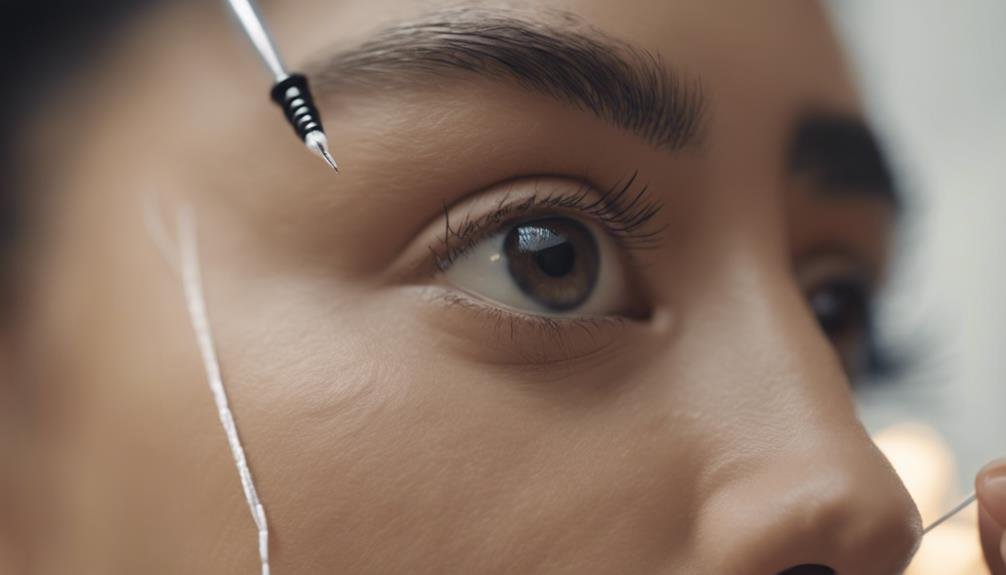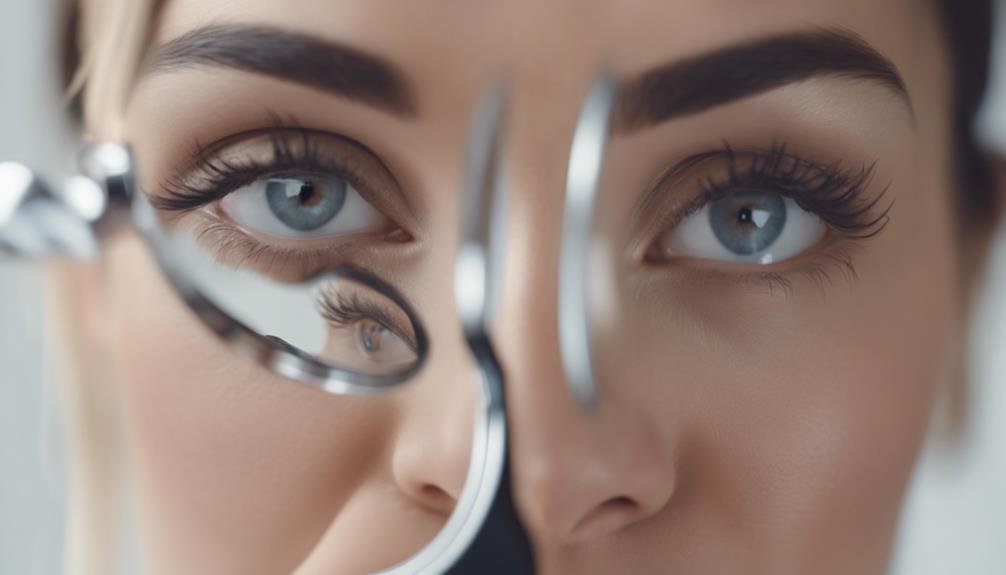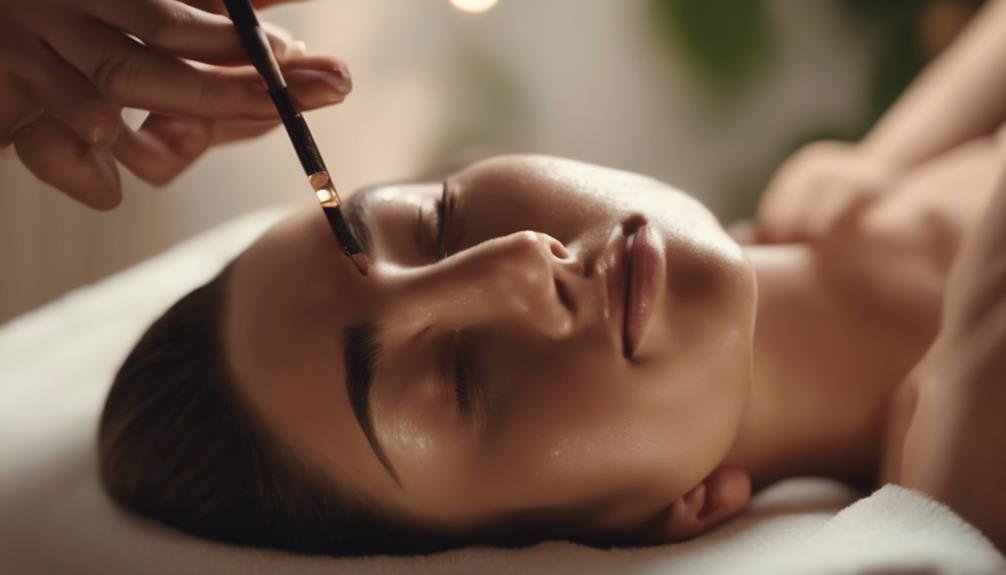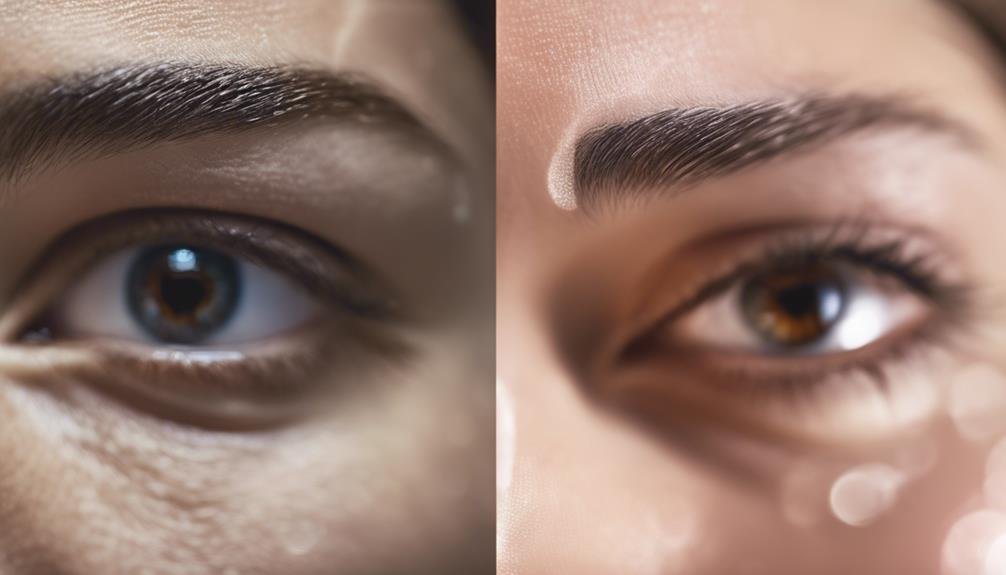When deciding between eyebrow threading and waxing, you’ll want to weigh factors like pain tolerance, precision, and skin sensitivity. Threading, an ancient cotton thread method, is known for its meticulous shaping and suitability for sensitive skin. On the other hand, waxing can cover larger areas quickly but might cause redness and irritation. Each method has pros and cons, and understanding them can help you make an informed choice. So, which technique aligns best with your needs and lifestyle? Let’s explore further to find out.
Key Takeaways
- Threading offers precise shaping and is gentler on sensitive skin while waxing quickly removes large sections of hair for bold brows.
- Threading is generally less painful and ideal for delicate skin, while waxing may cause redness and discomfort, especially in sensitive areas.
- Waxing provides exfoliation benefits and promotes finer regrowth, whereas threading is time-consuming but offers meticulous control over eyebrow shape.
- Threading results last about 4-5 weeks, while waxing results may last between 3-6 weeks but require more frequent touch-ups.
- Threading is safer for retinoid users and sensitive skin, whereas waxing is unsuitable due to potential skin irritation.
What Is Eyebrow Threading?

Eyebrow threading is an ancient technique that uses a cotton thread to trap and pull out individual hairs with precision. This hair removal method has been trusted for centuries and offers a refined way to shape your brows. Unlike other methods, eyebrow threading doesn’t require a specific hair length, making it accessible anytime needed.
When you opt for threading, the technician skillfully twists the thread along your brow line, catching and removing hairs from the follicle. This precision allows perfect shaping, catering to any brow shape you desire. Threading is especially beneficial for the delicate skin around your eyes, as it doesn’t involve harsh chemicals or heat that can irritate or damage sensitive skin.
However, threading can be more painful when fewer hairs are removed. The process involves pulling out each hair individually, which can cause discomfort if you’re sensitive to pain. Yet, the control and precision you get from eyebrow threading often outweigh this minor drawback.
What Is Eyebrow Waxing?
Switching gears from threading, waxing offers another effective method for shaping and maintaining eyebrows. This hair removal method involves applying melted wax to your eyebrow area, allowing it to adhere to the hair. Once the wax cools and hardens slightly, a quick pull removes the hair from the root, leading to a smooth and polished look.
Waxing is a popular choice because it offers results lasting between 3 to 6 weeks. Waxing pulls the hair out completely, unlike shaving, which only cuts the hair at the surface. This means you can enjoy a longer-lasting smoothness. Over time, regular waxing can even result in finer and sparser hair regrowth, making maintenance easier in the long run.
Different types of waxes are available for eyebrow waxing, catering to various skin types and sensitivities. Whether you opt for hard wax, soft wax, or a specialized formula, the goal is to efficiently remove unwanted hairs and define your eyebrow shape.
Pros of Threading

Opting for threading brings many benefits, especially for those seeking a less painful and more precise method of eyebrow shaping. Threading is less painful than waxing, making it a preferred choice if you have a low pain tolerance. This method is also free from the risk of burns or swelling, guaranteeing a safer hair removal experience. If you have sensitive skin or are prone to acne, threading is particularly suitable for you, as it causes less irritation than other hair removal methods.
One of the standout advantages of threading is its precision. The technique allows for better control, enabling the stylist to shape your eyebrows accurately. This means you can achieve the desired eyebrow shape without worrying about over-plucking or uneven lines.
Additionally, threading offers longer-lasting results. Typically, the effects can last between four to five weeks, so you won’t have to worry about frequent touch-ups. This makes threading effective and convenient, giving you more time to enjoy your perfectly shaped eyebrows without the hassle of constant maintenance.
Cons of Threading
Despite its many benefits, threading does have drawbacks that you should consider. One of the main issues is that threading can take slightly longer than waxing because each hair is removed individually. This precision requires patience and time, which mightn’t be ideal if you’re in a hurry.
Another downside is the potential for irritation. If the esthetician uses an incorrect technique, you could experience redness, swelling, or even small cuts on your skin. Moreover, incorrect threading can also lead to ingrown hairs, which aren’t only unsightly but can also be painful. These ingrown hairs occur when hair grows back into the skin rather than up to the surface, often causing inflammation.
Additionally, some people might find threading uncomfortable, especially with sensitive skin. The process involves a twisting motion that can be particularly painful around the delicate eye area. In rare cases, there have been reports of molluscum contagiosum, a viral skin infection transmitted through threading.
Lastly, threading requires a highly skilled esthetician to achieve the best results. Not all practitioners have the same level of expertise, so finding a qualified professional is essential to avoid these cons.
Pros of Waxing

Waxing offers a quick and efficient way to remove unwanted hair, leaving your skin smoother and softer. Eyebrow waxing is a popular method for shaping and maintaining brows, delivering professional results with minimal hassle. One of the significant advantages of waxing is its ability to remove hair from the root, which not only leaves your skin feeling smoother but also means you won’t have to deal with stubble for longer.
When you choose eyebrow waxing, you can expect the following benefits:
- Long-Lasting Results: Unlike other hair removal methods that may need weekly attention, the results from waxing can last between 3 to 6 weeks, depending on your hair growth rate.
- Exfoliation: Waxing doesn’t just remove hair and removes dead skin cells, giving you an added exfoliation benefit that leaves your skin looking fresh and rejuvenated.
- Finer Regrowth: Regular waxing can result in finer and sparser hair regrowth over time, making future sessions more manageable and less painful.
Additionally, the variety of waxes available means you can find one that suits your skin type and preference, ensuring a comfortable experience every time.
Cons of Waxing
While waxing offers several benefits, it is important to know the potential downsides. One of the immediate effects you might experience is redness and irritation, especially if you have sensitive skin. This can leave your skin looking inflamed and feeling sore after the procedure.
Another concern is over-waxing, which can damage hair follicles and result in thinning eyebrows. If you wax frequently, you could risk long-term harm to your brows. Additionally, the results from waxing are not permanent; hairs can regrow within just a few weeks, requiring you to maintain a regular waxing schedule.
If you’re using retinoids on your face, waxing might not suit you. Retinoids increase skin sensitivity, making it more prone to irritation and potential skin damage from waxing. Incorrect waxing techniques can also lead to discomfort, ingrown hairs, and other skin issues.
| Concern | Description | Impact |
|---|---|---|
| Redness and Irritation | Skin can become inflamed and sore, especially for sensitive types | Temporary discomfort |
| Over-waxing | Damage to hair follicles, leading to thinning eyebrows | Long-term thinning |
| Frequent Maintenance | Hair regrowth within weeks necessitates regular waxing | Time-consuming |
| Unsuitable for Retinoids | Increased skin sensitivity when using retinoids | Higher risk of irritation |
| Incorrect Techniques | It can cause discomfort, ingrown hairs, and potential skin damage | Unpleasant experiences, skin issues |
Awareness of these cons can help you make a more informed decision about using waxing for eyebrow maintenance.
Which Method Is Better?

Choosing between eyebrow threading and waxing ultimately depends on your skin type, pain tolerance, and desired results. Both methods have their unique benefits and drawbacks, making one more suitable for you than the other.
- Precision: Threading offers greater control over your eyebrow’s shape by removing one hair at a time. This method is ideal if you’re aiming for a meticulously sculpted look. Conversely, waxing can quickly remove larger sections of hair, which is perfect for achieving bold, strong-shaped brows.
- Pain and Sensitivity: Threading is generally less painful and more suitable for sensitive skin, but it takes longer. Waxing can cause sensitivity and discomfort, especially if you have delicate skin. If pain tolerance is a concern, threading might be the better choice.
- Longevity: Threading lasts longer, typically around 4-5 weeks, as it removes hair from the root. Waxing offers results that may last between 3-6 weeks. If you prefer fewer touch-up sessions, threading might be more advantageous.
Ultimately, your choice between threading and waxing should align with your needs and preferences. Consider these factors to determine which eyebrow grooming method suits you best.
Conclusion
Whether you choose eyebrow threading or waxing depends on your preferences and needs. If you have sensitive skin and want precise shaping, threading is your best bet.
On the other hand, if you’re after long-lasting results and don’t mind a bit of redness, waxing might be more your style. Both methods have pros and cons, so weigh them carefully to decide what’s best for you.
Remember, it’s all about what makes you feel confident and comfortable!
FAQs
1. Is threading or waxing better for sensitive skin?
Threading is generally better for sensitive skin because it doesn’t involve harsh chemicals or heat. It removes hair by trapping it with a cotton thread, which is less likely to irritate than waxing.
2. How long do the results of threading and waxing last?
Threading typically lasts about 4-5 weeks, while waxing results can last between 3-6 weeks. Both methods remove hair from the root, but threading can offer slightly longer-lasting results with fewer touch-ups needed.
3. Can I get an eyebrow threading or waxing if I use retinoids?
Threading is a safer option if you use retinoids. Waxing can cause significant irritation and damage due to increased skin sensitivity, while threading is gentler and less likely to harm retinoid-treated skin.
